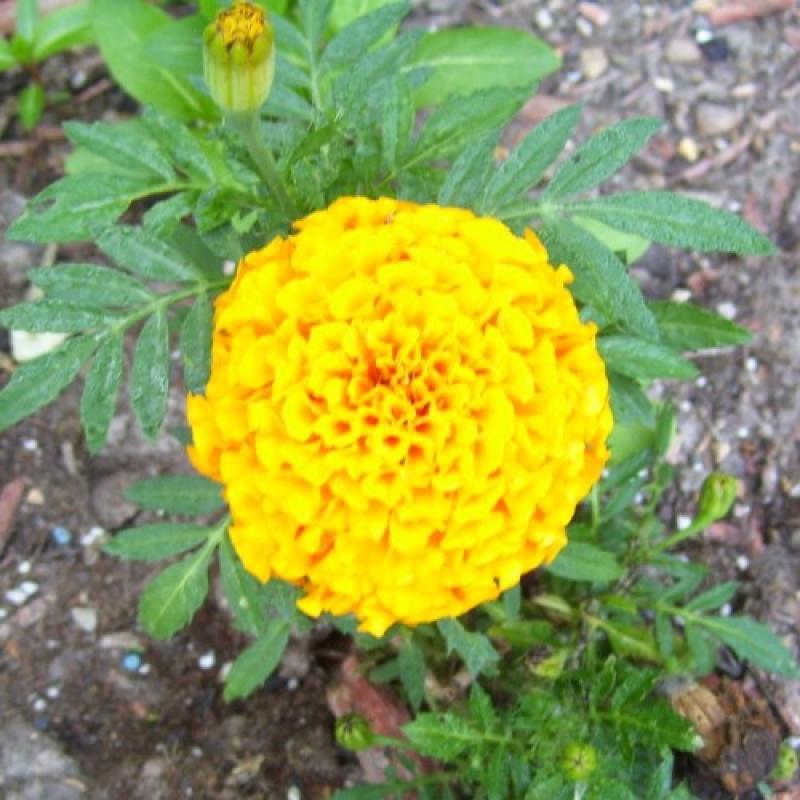
The Garden Chronicles - Week 13
It finally rained. I got a little over an inch a few days ago, but it wasn't much help. All it really did was green the grass up a bit, and increase the humidity. June is usually one of the wetter months, if not the wettest, but not this year. I hope it rains a good amount in July. If it doesn't, I'll be gardening in drought conditions.
It's been hot, too. Heat indexes over 100 lately. It's even staying hot well into the evenings when I'm trying to hoe or water the garden. I could almost water the garden with sweat sometimes.
On the bright side, I haven't seen any Japanese beetles yet this year. I hope they stay away. They've been a problem in the past.

Right around sunrise this morning, with dew on the asparagus on either side of the garden. I trim them like hedges every now and then, if anyone was wondering about that. If I don't, they grow these really long messy stalks that fall all over the place and break off at the ground in strong wind.
.

Hazy summer morning air.
.

Corn.
.

Another view.
.

Rutgers tomatoes. I pruned all of the tomatoes in the garden on Wednesday. I decided on 3 vines per plant. I'd usually go with 4 or 5, but I have a few more plants than normal this year.
.

For anyone who doesn't know, indeterminate tomatoes (all I'm growing this year) are continuously vining, meaning they will go and go and go until something kills them, making new vine after new vine after new vine (from suckers, shown by arrows in the photo) until you have a giant, unmanageable mess on your hands if you don't prune them. You don't absolutely have to prune them, of course, but you'll probably need to support them with big, strong cages if you don't. I'm using stakes, so I pretty much have to prune (it would be almost impossible to tie them all up if I didn't). The suckers always grow out of the node or joint where a leaf truss connects to the vine, the 'crotch' or 'armpit' of the branch, so to speak (see red arrows).
.

To prune indeterminate tomatoes, the first thing you need to do is decide how many vines you want per plant, and then allow suckers on young plants to grow until you have that number. After that, you pinch or cut off all remaining suckers, and continue doing so for the rest of the season (3 to 5 days is a decent pruning interval). Be careful of the vine tips (they're hard to see above, but they're circled in red on this plant). The tips contain the machinery for making new vine, leaf trusses, and fruit trusses. If you pull the tip off of a vine it won't die, but it won't be able to add more new growth either. They're usually curly and have white fuzz on them (you can kind of see that in the top circle).
.

I pruned all of my tomatoes to look something like this. I kept a couple early suckers coming out of the main vine (red arrows) for a total of 3 vines, and removed all other suckers. If anyone has any questions about pruning, just ask me in the comments.
.

I can hardly believe this, but 2 potatoes and several onions are actually making a comeback.
.

The other potato and some onions. I really thought they were going to die because of all the extra rain in May. They looked pretty bad a few weeks ago.
.

Lettuce. I've finally started picking it.
.

One of the Parris Island Cos romaines.
.

One of the Cimarron romaines.
.

Carrots. I dug a couple samples. They're almost ready.
.

Here's the result of the experiment. The row on the right germinated under the boards, the row on the left didn't (it may look empty, but there are some seedlings there, fewer and smaller by comparison).
.

The pathetic third try at beans. Almost laughable. They should fill out and give me some beans eventually, though.
.

Say goodbye to the first batch of turnips and beets. They're getting pulled and put in the fridge tomorrow night.
.

The butternut squash plants. Man, I wish they had all come up at the same time like they were supposed to. Now I have to be careful when I harvest them, to make sure the younger ones are fully mature (some will probably be mixed with older ones).
.

I've been picking kohlrabi and I think I'm sold. I really like it. It grew easily from a spring planting, and you can eat the whole plant. You can put it in a salad like you would radishes, or sauté it in a little butter and eat it as a side dish, or add it to stir fry. I think you can even shred it and make slaw. The leaves are thick and cabbagy, kind of like collards. All of mine have been tender and mild so far. They're great. I honestly can't believe that I've never grown them before. The tap root is hard as heck to cut off the bottom, though. I ended up using wire cutters on them. 
.

The Big Beef tomatoes, pruned to 3 vines each.
.

They're starting to load up. 
.

The nearly-drowned peppers are still making a comeback (except for that one). The eggplants behind them are too.
.

They're even trying to make peppers, as small as the plants still are.
.

The backup peppers are actually bigger than the other ones now. They're still busy growing, though. No peppers on them yet.
.

The backup eggplants. Starting to add new growth.
.

First and second cucumbers. The third will be planted on the next trellis this coming week.
.

Watermelon plants.
.

Blackberries still ripening. You can see the bird netting against a frame post in this shot, but nowhere else. It's there, though.
.

Cantaloupes.
.

Zucchini plants.
.

Zucchini. I'm not sure what's on them, whether it's dew, or dirt from watering, or even some kind of mold. I didn't notice that when taking the picture. I'll have to go check on that.
.

The planter with lettuce and backup Waltham Butternut. I'm thinking about putting one of the butternuts on an open trellis. I've never grown it vertically before.
.

Yellow marigolds and white petunias.
.

Verbena in a flower bed.
.

Verbena in a flower pot.
.

Cone flowers.
.

Cone flowers.
.

A single rose popped back out of the vines.
.

The redbud trees are covered with seedpods.
.

Apples on the mystery tree.
.

Another one.
.

Most of them fall off early like this one, though. Actually, they usually fall off when they're a lot smaller than this one. That tree is so frustrating.
.

A water turtle covered in algae. Probably looking for a spot to lay some eggs. They do that all over the front yard. I don't know why they lay them so far away from the water, but they do.
.

Some kohlrabi and a couple of cucumbers from the garden.
.

Blackberries.
.

See you next week.


I hope everyone had a happy 4th.
A/noon Dig. Geez everything is looking fantastic...One thing though..Don't you use mulch etc to cover your dirt??..we do here as it stops the ground from drying out and saves water and your plants..We use pea straw, straw and sugar cane mulch..pile it on about 10 centimetres thick. Nothing much can survive in heat unless the dirt and plant roots are kept moist and cool as much as possible..You will find it will make a huge difference. And as it breaks down the mulch enriches your soil..So happy plants and happy gardener....
I'm not generally a big fan of mulch. It gets in the way of my hoeing (I might be the only person in the world who enjoys hoeing), and it can be like a 5-star hotel for bugs. It can also get full of mildew and mold, being damp underneath all the time. I know a lot of people use it, but I never do. I would really only use it around the trellises and tomatoes, anyway - the stuff with the leaves up in the air and off the ground. Everything else pretty much shades the ground underneath with its own foliage.
I do ok without it. Thanks for the advice, though. I do appreciate it.
Ahhhh Blackberry cobbler with globs of cream.
(For city people - you take your fresh cow milk - put it in the 'fridge. Next morning the cream has risen to the top thicker than the whipping cream you find in the store. Don't bother whipping this stuff - just spoon a big glob on your cobbler and enjoy.)
Blackberry pie or blackberry jam with cream on fresh bread...Yum...cobbler sounds very nice to...
I've already had one of those. I ate it with ice cream, though
That was quite a show. Thanks.
The first few images and captions were a little confusing at first as to whether the caption belonged to the image above it or below it, until I got to the red arrows where it became clear which way they worked. If what you do is post an image, then a caption below it, then a space, then then next image, what will happen is that when you post the whole article the spaces close up and it will still look like what we see above. What I suggest so that each image is directly connected above its caption and then a space divides that from the next image and caption, as I have learned from posting many photo-essays, is as follows:
(image)
(caption)
(period - i.e. the punctuation)
(image)
(caption)
(period)
(image)
and on and on. That way under each caption before the next image, a space will exist when you post the article, and nobody will notice the period, they will just appear to be spaces. That will make it obvious that specific images and their captions are individually isolated, separated from others, and the whole photo-essay is very easy to follow.
That's not a bad idea. The spacing has been bugging me as well. I edited it to add separations.
I'm playing around with it now. I put the first dozen periods in the middle, and the rest are on the side. Which looks better?
It's a shame the editor won't just allow an intentional space line. It also won't keep center alignment turned on. I have to select it for every damn new line.
I think your photo-essay looks better now, and as I said it would be, it's easier to follow. Since the periods are almost invisible it doesn't make any difference if they are centred or on the side. I don't bother to centre my photos and captions. What if you didn't centre the individual images and captions while posting them and then when they are all posted marked the whole thing with your cursor and centred the whole essay together? Would that not centre the whole thing with one shot?
What's on the zucchini might be downy mildew, check and see if the fruit is becoming mushy, if it is pick them off and discard in a way that doesn't allow the spores to be released and you may need to use an antifungal.
Yes, finally, we had a rain yesterday, UGH, it lasted a few minutes and settled the dust.
It wasn't dirt or dew, it does have something on it.
I don't know if I have anything for a fungus. I guess I could get some. That was the first plant I put out, though. It's the one that suffered through the abnormally cold and wet May. It's getting old enough that I'd just as soon pull it than bother trying to save it.
Do you know if that fungus stays in the ground where the plant was, or does it just come in on the air? I'm going to need that space for a future plant.
I wouldn't plant anything from the squash family in the area for a couple years or more, do a rotation of say rye to turn back into the soil, then corn, then a lower crop like beans, a root crop, and then back to squash. The spores are in the ground and once it contaminates a fruit it becomes airborne. It's similar to how you would treat brown blossom rot in tomatoes just keep rotating the crop around the garden until the spores in the ground die out. But like you said the plant has produced enough already, just pull it
Well, I do rotate things year to year, but I'm going to stick another zucchini right there before too long. That's pretty much my normal routine. I guess we'll see what happens. A young and healthier plant might do alright.
Good news. I checked it again this morning and whatever it was is gone. The plant is clean. Weird.
Not downy mildew, so in your picture is the soil wet/damp and is it dry now? It could've been just a ground fungus that made its way onto whatever was on the ground.
It had been watered the evening before, and was watered in the morning yesterday and today. They get water every day.
Later on that day I cut some of the lower leaves off that were yellowing. I imagine doing that let more sun down there, which might have been what cleaned it up.
I think I got the last of the lettuce from my garden. I picked some Thursday, and it was just a tad bitter. Not bad, really, but the rest is starting to get leggy, so I imagine it will go to seed soon. Our temps have been in the 90s, and lettuce likes it cool, so no surprise there.
Something is eating my cucumber vines. I suspect a rabbit. It's too hot to leave the dog out to guard the cukes, and I couldn't find fencing supplies to mend my fence. At this point, I'll be happy if I can keep my strawberry vines alive and uneaten to start over again next spring.
My pear trees are loaded down with pears - the deer and our neighborhood bear will be getting those. And I'm going to have to take a pic of some mystery fruit that another tree has started bearing this year. This tree was planted before I moved in 10 years ago, and never produced fruit until last year. I think it's a plum, but I'm really not sure. Its flavor leaves much to be desired.
Are there little chunks of torn leaves laying around the plant? I think rabbits will do that with things like cucumber and cantaloupe leaves. Could be wrong, though.
What kind of mending does it need? You could probably find a small spool of wire and thread some of it through a torn area if you needed to. Just as a temporary, stop-gap thing. All you'd need are some pliers and wire cutters. Depending on the gauge of the wire, you might not even need the pliers.
Oooh. Mystery fruit. I'm looking forward to trying to help figure it out.
No chunks of torn leaves. Just vines that have obviously been shorn since I last saw them. And I've seen a rabbit lurking.
As far as the fence goes, the guys who mow my yard have beaten the wire up with their weed eaters. I know they can't help it, if I want that area trimmed. But I'm not sure it can be woven with just wire at this point.
The mystery tree is a plum. They tasted horrible because they're falling long before they're ripe. Now that some are ripe, I can only see about 4 of them on the tree. The one I tried today was pretty good, but small. Maybe it'll do better going forward.
My grandma had a plum tree once. It looked more like a big bush than a tree, though. I remember them being pretty good when ripe.
She also had a couple of small pear trees. They were good, but often had brown splotches on them.
My apple tree drops most of its fruit before it's ripe, too. I read it might be because of bad germination. In addition to not being the variety it was supposed to be, it's probably not the self-pollinator it was supposed to be either. Like I said somewhere before, if its flowering time doesn't overlap with the crabapples in the yard (which can pollinate it), then it doesn't produce very well, and they didn't overlap much at all this year. I should have replaced it years ago, but I kept hoping...
I used to have another plum tree, but one spring it just didn't leaf out. Not sure what happened to it. It had good fruit, but in pretty small quantities. My pear trees produce well, but I don't like pears, so I really don't do anything with those. They end up being a treat for local wildlife. All of the trees waited to produce until I'd lived here for 4 or 5 years, so maybe it's just not good soil, or the elevation is too high for fruit trees to thrive.
Maybe bad germination is the problem for this plum. There aren't any other plum trees around, and I don't know if they self-pollinate. It's pretty when in bloom, so even if it doesn't produce well, I'll leave it alone.
Looking good.
Now I want some peppers.
Sorry to hear you are so dry, we have had nothing but rain the last couple of days.
Yard is a soggy mush and needs to be mowed, yet so wet I can't.
Good news is my little tree has sprouted several new leaves so I think it is going to make it.
That's good to hear.
Rain, glorious rain. Finally got a break and got a soaker, the last rain like this was June 10th. Probably not much more than 1/2 inch, but we'll take it.
My garden is way behind and I want some of my own vegetables. I have had a few tomatoes real early but just a few to tease me